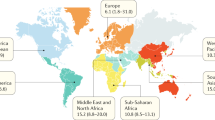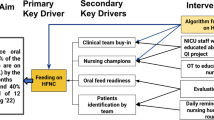Abstract
Objective:
We wished to compare the efficacy of light-emitting diode (LED) phototherapy with special blue fluorescent (BB) tube phototherapy in the treatment of neonatal hyperbilirubinemia.
Study design:
We randomly assigned 66 infants⩾35 weeks of gestation to receive phototherapy using an LED device or BB. In addition to phototherapy from above, all infants also received phototherapy from below using four BB tubes or a fiberoptic pad.
Result:
After 15±5 h of phototherapy, the rate of decline in the total serum bilirubin (TSB) was 0.35±0.25 mg/dl/h in the LED group vs 0.27±0.25 mg/dl/h in the BB group (P=0.20).
Conclusion:
LED phototherapy is as effective as BB phototherapy in lowering serum bilirubin levels in term and near-term newborns.
This is a preview of subscription content, access via your institution
Access options
Subscribe to this journal
Receive 12 print issues and online access
$259.00 per year
only $21.58 per issue
Buy this article
- Purchase on Springer Link
- Instant access to full article PDF
Prices may be subject to local taxes which are calculated during checkout

Similar content being viewed by others
References
Ennever JF . Blue light, green light, white light, more light: treatment of neonatal jaundice. Clin Perinatol 1990; 17: 467–481.
McDonagh AF, Agati G, Fusi F, Pratesi R . Quantum yields for laser photocyclization of bilirubin in the presence of human serum albumin. Dependence of quantum yield on excitation wavelength. Photochem Photobiol 1989; 50: 305–319.
Maisels MJ, Baltz RD, Bhutani V, Newman TB, Palmer H, Rosenfeld W et al. Management of hyperbilirubinemia in the newborn infant 35 or more weeks of gestation. Pediatrics 2004; 114: 297–316.
Vreman HJ, Wong RJ, Stevenson DK . Light-emitting diodes: a novel light source for phototherapy. Pediatr Res 1998; 44: 804–809.
Seidman DS, Moise J, Ergaz Z, Laor A, Vreman HJ, Stevenson DK et al. A prospective randomized controlled study of phototherapy using blue and blue-green light-emitting devices, and conventional halogen-quartz phototherapy. J Perinatol 2003; 23: 123–127.
Seidman DS, Moise J, Ergaz Z . A new blue light-emitting phototherapy device: a prospective randomized controlled study. J Pediatr 2000; 136: 771–774.
McDonagh AF, Nguyen ML . Spectacles, ultraviolet radiation, and formation of cataracts. N Engl J Med 1989; 321: 1478–1479.
Jährig K, Jährig D, Meisel P . Dependence of the efficiency of phototherapy on plasma bilirubin concentration. Acta Paediatr Scand 1982; 71 (2): 293–299.
Acknowledgements
This study was supported by a grant from Natus Medical Inc., San Carlos, CA, USA. We thank Antony F McDonagh, PhD for his review and helpful comments.
Author information
Authors and Affiliations
Corresponding author
Rights and permissions
About this article
Cite this article
Maisels, M., Kring, E. & DeRidder, J. Randomized controlled trial of light-emitting diode phototherapy. J Perinatol 27, 565–567 (2007). https://doi.org/10.1038/sj.jp.7211789
Received:
Revised:
Accepted:
Published:
Issue Date:
DOI: https://doi.org/10.1038/sj.jp.7211789
Keywords
This article is cited by
-
History and current standard of postnatal management in hemolytic disease of the fetus and newborn
European Journal of Pediatrics (2022)
-
New high intensity fibreoptic phototherapy devices in healthy newborns: a single pad wrapped around the neonate body in comparison with a double pad device
Italian Journal of Pediatrics (2019)
-
LED-phototherapy does not induce oxidative DNA damage in hyperbilirubinemic Gunn rats
Pediatric Research (2019)
-
Efficacy of phototherapy devices and outcomes among extremely low birth weight infants: multi-center observational study
Journal of Perinatology (2013)
-
The effect of hematocrit on the efficacy of phototherapy for neonatal jaundice
Pediatric Research (2013)



